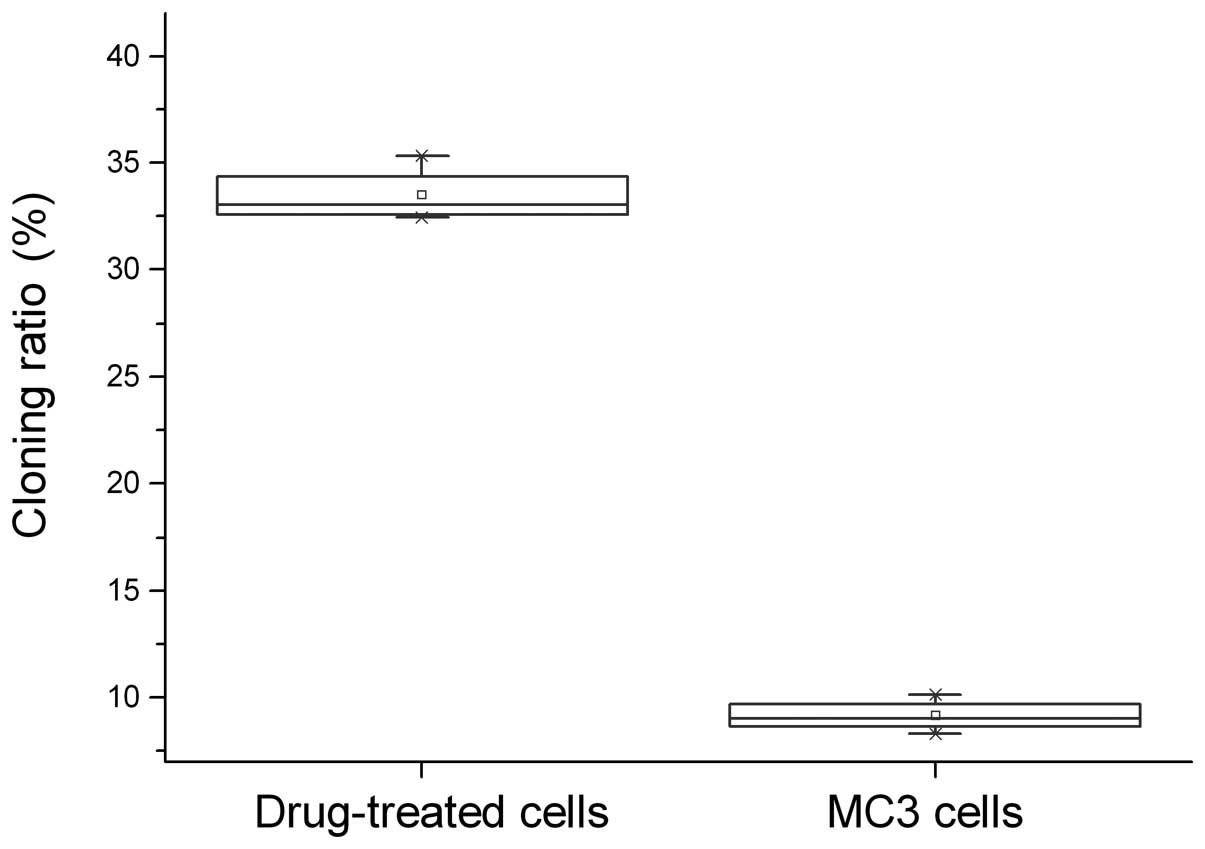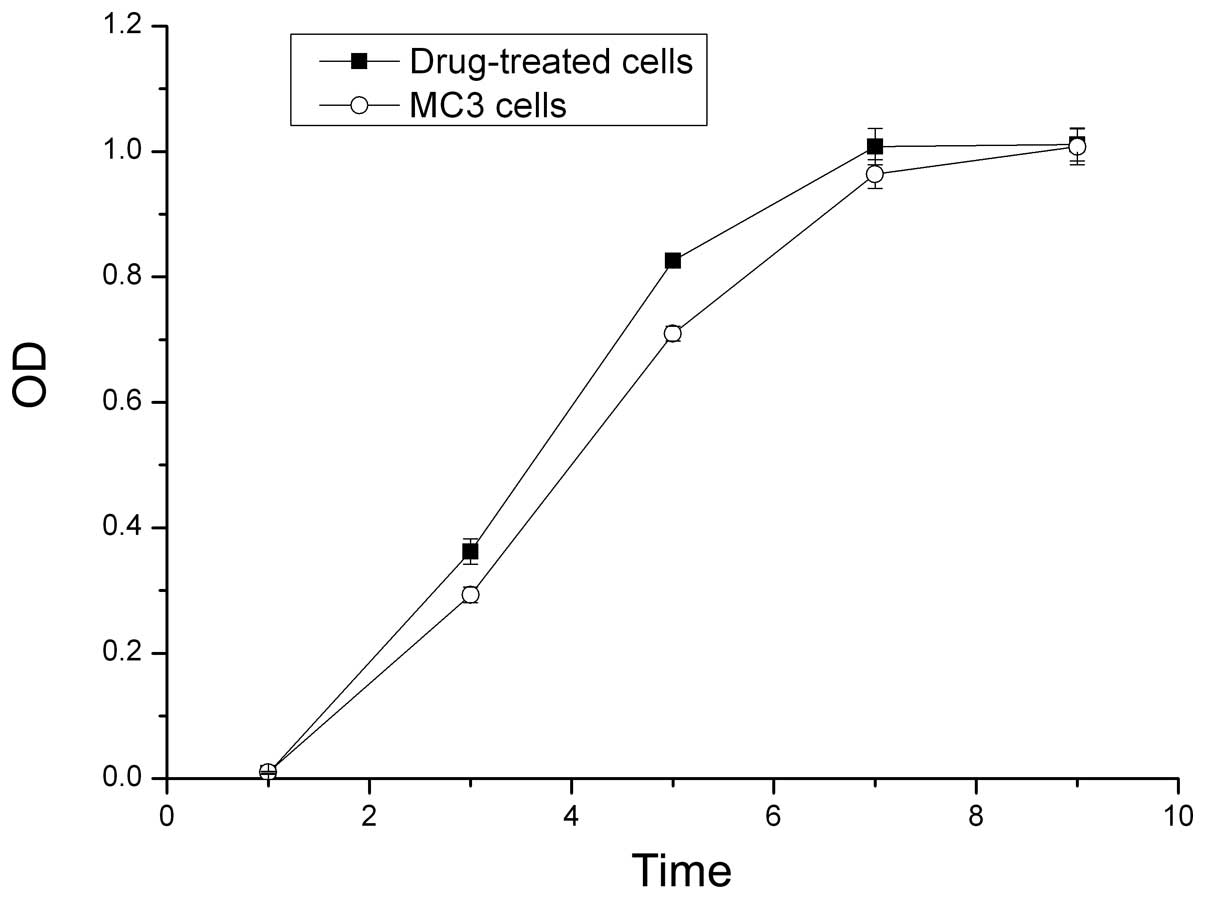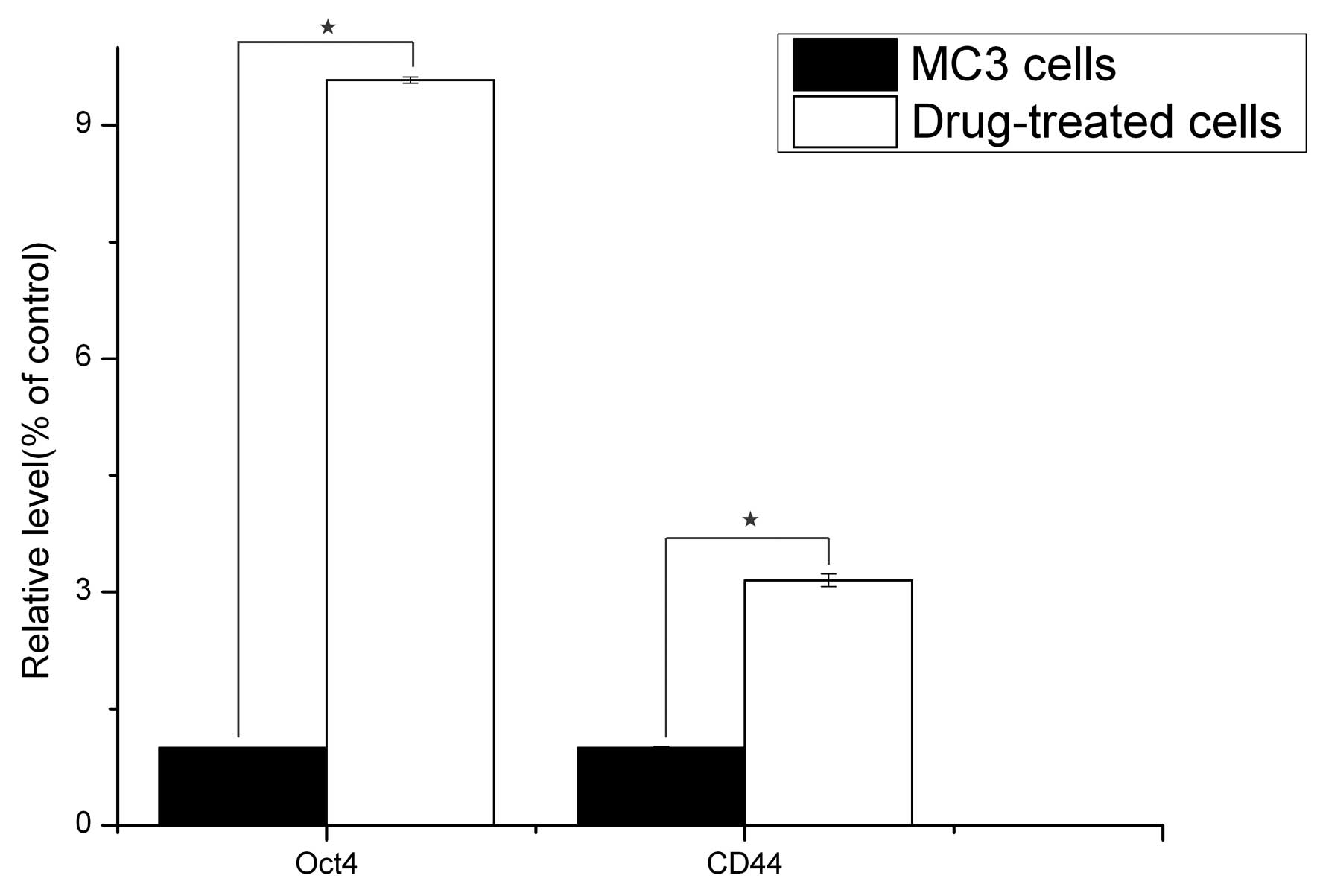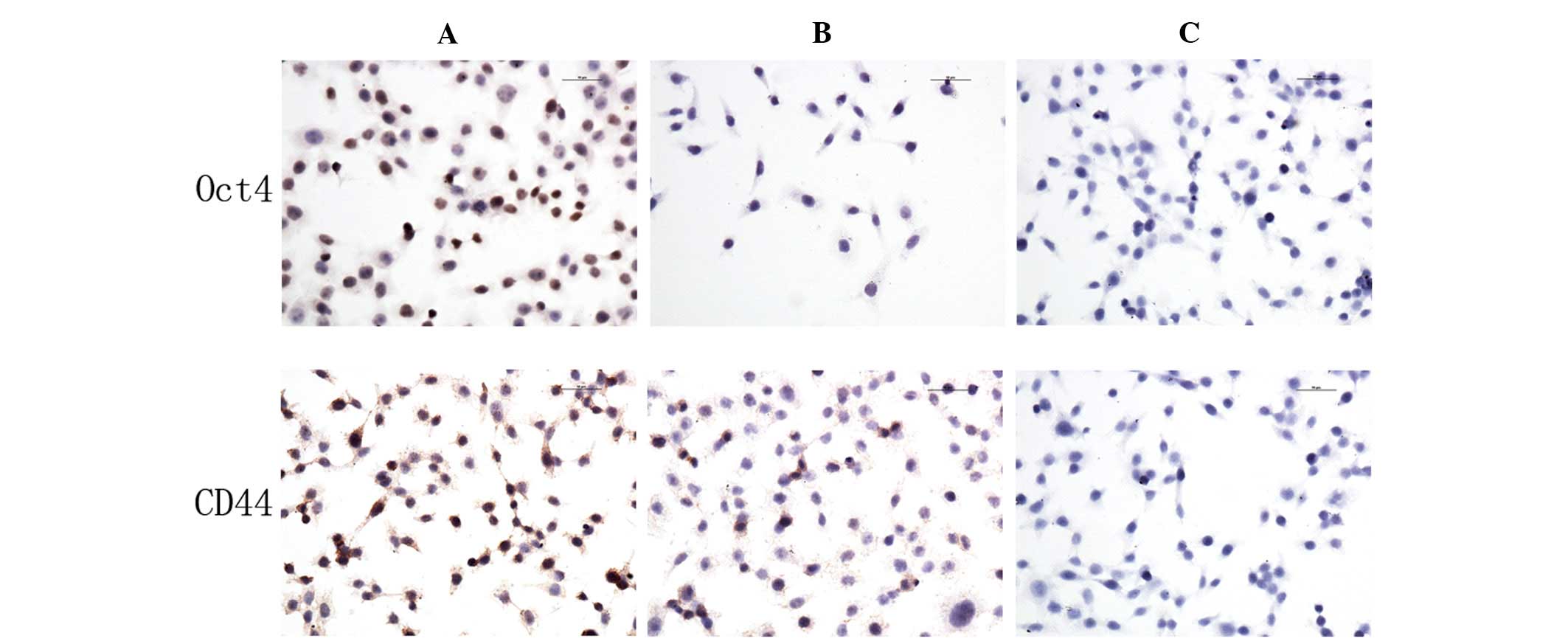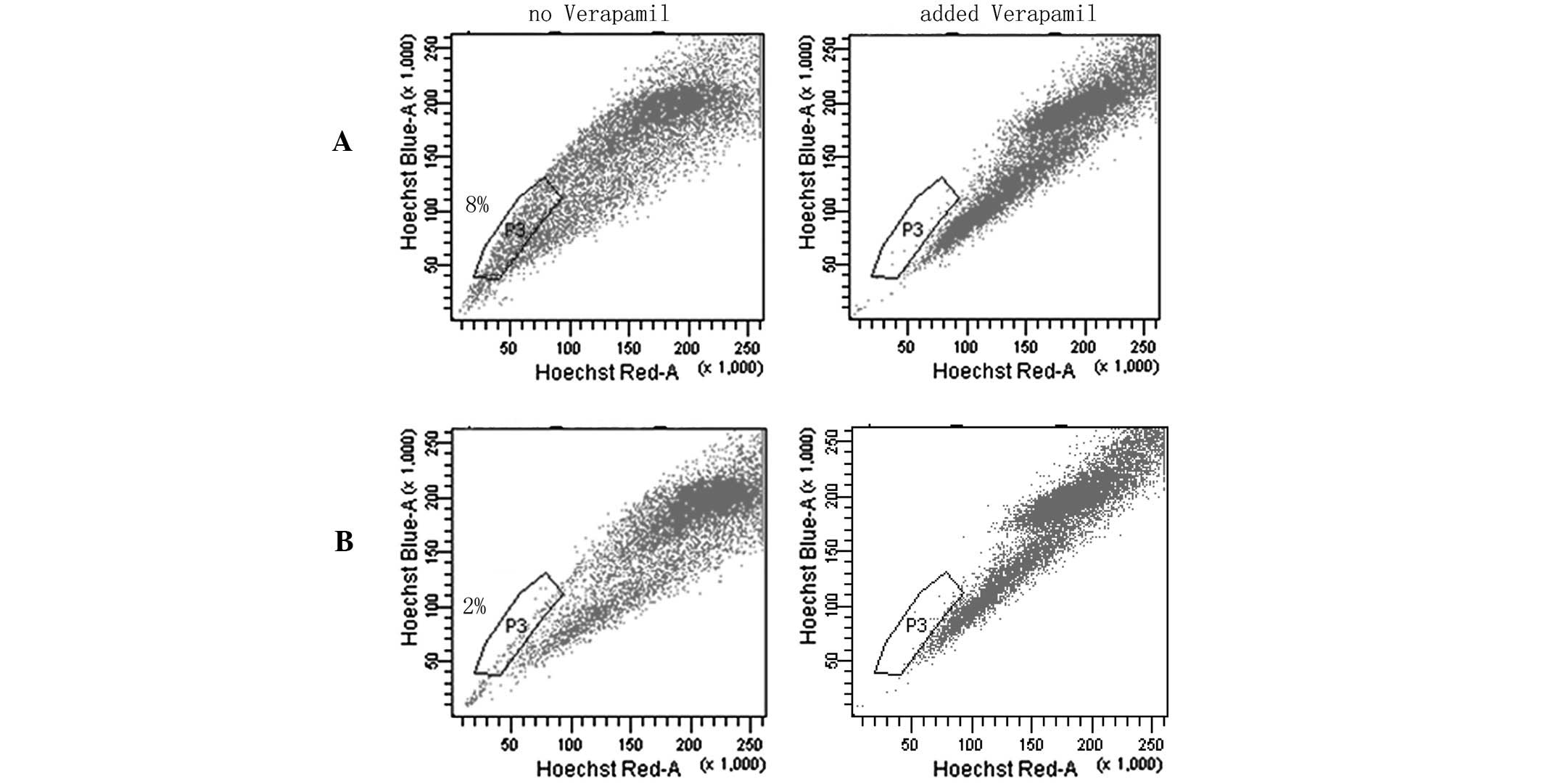MC3 Mucoepidermoid carcinoma cell line enriched cancer stem-like cells following chemotherapy
- Authors:
- Published online on: February 21, 2014 https://doi.org/10.3892/ol.2014.1902
- Pages: 1569-1575
Abstract
Introduction
Mucoepidermoid carcinoma (MEC) is common in human salivary glands. Poorly differentiated MEC is a lethal malignancy that readily invades nearby tissues and is likely to recur (1). Conventional surgery is the most common treatment method for MEC, however, often results in devastating functional and cosmetic consequences. In order to kill residual tumor cells and prevent the recurrence of MEC, chemotherapy is required following surgery. The chemotherapeutic agent, 5-fluorouracil (5-Fu), is commonly used; however, chemotherapy is unable to kill all of the remaining tumor cells or prevent the recurrence of MEC. The underlying mechanisms of MEC recurrence following chemotherapy have not yet been investigated.
Cancer stem-like (CSL)-cells are a rare population of cancer cells exhibiting stem cell properties, constituting a reservoir of self-sustaining cells with an exclusive ability to self-renew and maintain the tumor. CSL-cells were identified first in acute myeloid leukemia (2) followed by solid tumors and subsequently breast cancer in 2003 (3). CSL-cells have been isolated from a variety of human malignancies, including leukemia (2,4), breast cancer (3,5), brain tumors (6–8), hepatocellular carcinoma (9), pancreatic (10) and colorectal cancers (11,12), melanomas (13), prostate cancer (14) and bone sarcomas (15). CSL-cells are significant in tumor formation and growth (16–18). Potentially quiescent CSL-cells, which are vital and capable of repopulating under cancer therapies, may be a source of recurrence and drug resistance (3,19).
The present study aimed to investigate the effects of chemotherapy on the MC3 MEC cell line and the potential roles of CSL-cells in recurrent MEC following chemotherapy.
Materials and methods
Cell line and culture
The MC3 MEC cell line was provided and conserved at the State Key Laboratory of Oral Diseases, Sichuan University (Chengdu, China). The MC3 cells were maintained in a serum-containing medium composed of RPMI-1640 (Hyclone, Logan, UT, USA) and 10% fetal bovine serum (FBS; Gibco-BRL, Grand Island, NY, USA). The cells were incubated at 37°C in a 5% CO2 humidified atmosphere and passaged once every three days.
MC3 cell culture in 5-Fu-containing medium
The MC3 cells were incubated in a serum-containing medium composed of RPMI-1640, 10% FBS and 1 peak plasma concentration of 100 μg/ml 5-Fu (20) at 37°C in a 5% CO2 humidified atmosphere for 24 h.
Soft agarose assays of clone formation
The 5-Fu-treated and parent MC3 cells were seeded in 24-well plates. Low melting-point agarose (0.3 ml, 0.6%; Type VII, Sigma-Aldrich, St. Louis, MO, USA) was poured into each well and 0.3 ml (0.35%) agarose containing 100 cells was subsequently added to each well. The cells were incubated following the solidification of agarose at room temperature. The number of clones containing >50 cells was counted under a microscope after ten days and the cloning efficiency was calculated using the following formula: Colony formation rate (%) = no. of clones/no. of cells incubated × 100.
MTT assay
The 5-Fu-treated and parent MC3 cells were seeded in 96-well plates, each well contained 2,000 cells and was cultured in complete RPMI-1640 medium with 10% FBS. The cell viability was measured using the MTT assay (Sigma-Aldrich). The optical density (OD) values were obtained using a microplate reader (ThermoElectron 3001 Varioskan Flash; USA) on days one, three, five, seven and nine.
Quantitative polymerase chain reaction (qPCR)
qPCR was performed using the SYBR® Green reporter to detect the expression of genes, cluster of differentiation (CD)44 and octamer-binding transcription factor 4 (Oct4). The primer sequences are summarized in Table I. The cells were harvested and RNA was extracted from the 5-Fu-treated and parent MC3 cells using TRIzol reagent (Invitrogen Life Technologies, Carlsbad, CA, USA), then reverse-transcribed into cDNA using PrimeScript RT reagent kit (Takara, Dalian, China) according to the manufacturer’s instructions. qPCR was performed according to the standard protocol of the SYBR Premix Ex Taq™ II kit (Takara) on an ABI 7300 Real Time PCR system (Applied Biosystems, Foster City, CA, USA). To quantify the changes in gene expression, the ΔΔCt method was used to calculate the relative fold changes following normalization using the internal reference gene, GAPDH.
Immunocytochemistry
The 5-Fu-treated and parent MC3 cells were plated on glass coverslips at 37°C overnight, washed twice with PBS, and immunostained for CD44, Oct4 and the isotype control. The primary antibodies included rat monoclonal anti-CD44 (dilution 1:100; eBiosciences, San Diego, CA, USA) and rabbit monoclonal anti-Oct4 (dilution 1:50; Bioworld Technology, Minneapolis, MN, USA). The secondary antibodies included goat anti-rat IgG and goat anti-rabbit IgG (dilutions 1:50; Bios, Beijing, China). The intensity of 3,3′-diaminobenzidine was analyzed using the immunohistochemical Avidin Biotin Complex (ABC) method (15). Images were captured using a Nikon eclipse 80i microscope (Nikon Corp., Tokyo, Japan).
Fluorescence-activated cell sorting (FACS) of CD44 and Oct4
The 5-Fu-treated and parent MC3 cells were trypsinized into solitary cell suspensions. The cells were counted, washed twice with PBS, resuspended in ice-cold PBS (supplemented with 2% FBS) and labeled with antibodies specific for human cells, such as rat monoclonal anti-CD44 antibody. The cells were incubated with their antibodies for 30 min at 4°C in the dark. The unbound antibodies were removed by washing twice with PBS. The fluorescein isothiocyanate (FITC)-labeled secondary antibody was added to the cell suspension and incubated for 30 min at 4°C in the dark. The cells were washed twice with PBS and FACS analysis (BD Biosciences, San Jose, CA, USA) was performed.
The 5-Fu-treated and parent MC3 cells were fixed and perforated, resuspended in ice-cold PBS and labeled with antibodies specific for human cells, such as rabbit monoclonal anti-Oct4 antibody. The cells were incubated with their antibodies for 30 min at 4°C in the dark. The unbound antibodies were removed by washing twice with PBS. The FITC-labeled secondary antibody was added to the cell suspension and incubated for 30 min at 4°C in the dark. The cells were washed twice with PBS and FACS analysis was performed.
Culture of the cells in serum-free medium
The 5-Fu-treated and parent MC3 cells were washed three times with PBS to remove all traces of FBS. The cells were placed in serum-free Dulbecco’s modified Eagle’s medium (DMEM)/F12 (Hyclone), which was composed of 20 ng/ml basic fibroblast growth factor (PeproTech, Rocky Hill, NJ, USA), 20 ng/ml epidermal growth factor (PeproTech), 1 mg/ml insulin (Sigma-Aldrich) and 2% B27 (Invitrogen Life Technologies) at a density of 1×102/ml. The cell suspensions (200 μl) were plated onto ultra-low attachment 96-well plates. The number of clones containing >50 cells was counted under a microscope on day seven and the cloning efficiency was calculated using the following formula: Colony formation rate (%) = no. of clones/no. of cells incubated ×100.
FACS analysis of side population (SP) cells
SP cell analysis was based on a previously described method (21) with certain modifications. Briefly, cells were trypsinized and resuspended in PBS with 2% FBS at a density of 1×610/ml. Verapamil (Sigma-Aldrich) at a final concentration of 50 μg/ml was added to the control group. After 10 min, 10 μg/ml Hoechst 33342 (Sigma-Aldrich) was added to the cell suspension, this was incubated in the dark for 90 min, centrifuged and resuspended in ice-cold PBS containing 2% FBS. Propidium iodine (2 μg/ml; Sigma-Aldrich) was added to separate the dead cells. Analysis and sorting were performed on a BD FACSAria.
Statistical analysis
Statistical analyses were performed with SPSS software, version 11.5 (SPSS, Inc., Chicago, IL, USA). All quantified data present the means of at least three samples and error bars represent the standard deviation. Student’s t-test was used to determine the statistical differences between the experimental and control groups. P<0.05 was considered to indicate a statistically significant difference.
Results
5-Fu-treated cells
The MC3 cells were exposed to 5-Fu for 24 h resulting in a large number of cell deaths. The dead cells were suspended in the medium and the surviving cells adhered to the plate wall. The viable cells were collected for subsequent experiments.
5-Fu-treated cells exhibit a higher cloning efficiency
The 5-Fu-treated and parent MC3 cells underwent the agarose colony formation experiments and showed that the cloning ratio of 5-Fu-treated cells (33.47±1.30%) was significantly higher compared with the parent MC3 cells (9.14±0.747%, P<0.05; Fig. 1).
Growth curves of the cells
The OD values from the MTT assay were used to construct growth curves. The proliferative ability of the 5-Fu-treated cells was higher compared with the parent MC3 cells in the first seven days. The 5-Fu-treated cells reached the plateau phase on day seven, whereas the parent MC3 cells reached the plateau phase on day nine (P<0.05; Fig. 2).
qPCR analysis
The gene expression status of CD44 and Oct4 were compared between the 5-Fu-treated and the parent MC3 cells via qPCR. The results revealed that the reference gene, GAPDH, was stably expressed in all the samples, and CD44 and Oct4 were significantly expressed in the 5-Fu-treated cells compared with the parent MC3 cells (P<0.05; Fig. 3).
CD44 and Oct4 protein expression
Immunocytochemistry assays were used to analyze the expression of CD44 and Oct4 in 5-Fu-treated and parent MC3 cells. The expression levels of CD44 and Oct4 in 5-Fu-treated cells were higher compared with the parent MC3 cells. CD44 was expressed in the cell membrane and cytoplasm, whereas Oct4 was expressed in the nucleus (Fig. 4).
Furthermore, the expression of CD44 and Oct4 was analyzed by FACS. According to three independent experiments, the expression levels of CD44 and Oct4 were 99.50±0.30 and 14.60±0.36%, respectively in the 5-Fu-treated cells, and 14.47±0.15 and 1.37±0.06%, respectively, in the MC3 cells (Fig. 5). The expression levels of CD44 and Oct4 were significantly different between the two cell populations (P<0.05).
Spheroid cells in the serum-free medium
The 5-Fu-treated and parent MC3 cells that were incubated in serum-free medium for one day revealed multicellular spheroids. Spheroids were apparent following cell culture in serum-free medium for four days (Fig. 6). The number of cells in the spheroids gradually increased in a time-dependent manner and on day seven spherical bodies comprising of dozens of cells were observed. The number of spherical bodies increased by >20% following treatment with 5-Fu. When the spheroid cells were cultured in RPMI-1640 with 10% FBS they became adherent. These findings identified that under stem cell culture conditions, MC3 and 5-Fu-treated cells formed spheroids, and chemotherapy may improve the ratio of the formation of spheroids.
SP cell assays
SP flow cytometry has previously been used to enrich cancer stem cells (CSCs) from various cancer cell lines and primary tumors (22–24). SP cells do not fluoresce under the dual wavelength parameters of FACS as they are able to efflux Hoechst 33342 by adenosine triphospate-binding cassette transporters (21,25–29). In the SP assays, SP cells were located in the area of weak fluorescence and the ratio of SP to 5-Fu-treated cells was higher compared with MC3 cells. These data strongly indicated that chemotherapy may significantly increase the number of CSL-cells in MC3 cells (Fig. 7).
Discussion
Previous studies have identified CSL-cells within tumors and that the injection of CSL-cells into nude mice induces the development of tumors. CSL-cells are considered to be comparable to normal tissue stem cells as they possess the ability to divide asymmetrically and symmetrically, and undergo multilineage differentiation (30,31). Similar to the activity of normal stem cells in the maintenance of tissue architecture, CSL-cells are regarded as a resource of tumor formation, progression, recurrence and drug resistance (11,32). CSL-cells are able to self-renew and differentiate into a diverse range of cells that form tumor masses (33,34). CSL-cells have a stronger resistance to traditional treatments, such as chemotherapy and radiation, compared with other types of tumor cells due to their high expression of drug resistant transporter proteins (such as ABC) (35–37), DNA repair enzymes (38,39) and anti-apoptotic proteins (40–42).
The present study indicated that the CSC phenotype may be induced by 5-Fu as cancer cells are able to acquire a stemness state, which is characterized by the increased stemness gene expression of Oct4. Oct4 is a typical stem-cell associated gene (43) and may be able to reprogram adult cells into induced pluripotent stem cells (iPS) (44,45). Despite the transcription factors of c-Myc, kruppel-like factor 4 and NANOG, Oct4 is an important gene as its expression is significant in the production of iPS (44,46,47). Previous studies identified a high expression of Oct4 in human embryonic stem cells compared with differentiated tissues and a high expression in CSL-cells compared with other types of cancer cells (18,48,49). In certain cell lines, the increased expression of Oct4 results in enhanced stemness and acquisition of a stem cell-like phenotype (50,51), which is associated with an increase in sphere formation and resistance to chemotherapy and radiotherapy. Knockdown of Oct4 may increase the sensitivity to chemotherapy and radiotherapy due to the restriction of the factors that lead to self-renewal. Therefore, the expression of Oct4 is important in the identification of CSL-cells.
As a type of transmembrane glycoprotein, CD44 is widely distributed on the cell surface of lymphocytes and fibroblasts (52). CD44 is predominantly involved in specific adhesion processes, such as cell-cell and cell-matrix. Thus, CD44 may be used as a surface marker of CSL-cells. In addition to breast cancer (3), CD44 was considered to be a CSL-cell marker in ovarian (53), prostate (54) and pancreatic cancer (10), and head and neck squamous cell carcinoma (55).
The present study demonstrated that the expression of Oct4 and CD44 increased following treatment with 5-Fu, particularly Oct4 expression in 5-Fu-treated cells, which was markedly higher compared with the parent MC3 cells. These findings were consistent with the increased stem cell-like phenotype, as the cloning ratio of the cells in the soft agarose increased from 9.14±0.747 to 33.47±1.30%. To examine this further, the 5-Fu-treated cells were cultured under stem cell culture conditions, which were selective for CSL-cell enrichment. The results indicated that chemotherapy was associated with a significant increase in sphere-formation ability, reflecting a greater self-renewal and proliferation ability of the 5-Fu-treated cells; furthermore, no difference in morphology was observed between the two types of spheroids. In addition, the 5-Fu-treated cells grew faster, reaching the plateau phase more rapidly than the parent MC3 cells in the MTT assays. These findings were consistent with previous studies, demonstrating that the drug resistance of tumor cells is associated with CSL-cells in tumors (17,56,57).
Over the past century, chemotherapy has been used extensively as a curative or adjuvant cancer treatment, particularly for metastatic tumors. However, the majority of human malignancies, including MEC, are resistant to this important therapeutic method. Resistance to chemotherapy is the primary obstacle for patient survival, particularly for those with metastatic tumors (58). In the present study, chemotherapy induced stem cell-like properties, such as sphere formation, clone formation and stemness-related gene expression, demonstrating that chemotherapy may enrich CSL-cells in the MC3 cell line. To further explore the number of CSL-cells in the 5-Fu-treated MC3 cells, flow cytometry using Hoechst 33342 dye exclusion was performed to isolate the SP cells that were enriched in CSCs. Notably, the drug-treated cells exhibited a higher percentage of SP cells compared with the parent MC3 cells; the CSC component in the MC3 cell line increased from 2 to 8% of the total cell population, indicating that they were more enriched for the CSC phenotype.
In conclusion, CSL-cells are considered to be a cause of tumors due to their similar characteristics to stem cells (self-renewal and multilineage differentiation). The present study indicated that 5-Fu may induce MC3 cells into a stem-like phenotype and that the remaining CSL-cells of MEC following chemotherapy were significant in tumor recurrence, as well as in promoting tumor survival. These findings demonstrated the mechanisms involved in the resistance of cancer cells to chemotherapy and implied that targeting CSL-cells may improve the efficacy of chemotherapy.
Acknowledgements
The present study was supported by the National Natural Science Foundation of China (grant nos. 30973345 and 81172578).
References
|
Spiro RH, Huvos AG, Berk R and Strong EW: Mucoepidermoid carcinoma of salivary gland origin. A clinicopathologic study of 367 cases. Am J Surg. 136:461–468. 1978. View Article : Google Scholar : PubMed/NCBI | |
|
Bonnet D and Dick JE: Human acute myeloid leukemia is organized as a hierarchy that originates from a primitive hematopoietic cell. Nat Med. 3:730–737. 1997. View Article : Google Scholar | |
|
Al- Hajj M, Wicha MS, Benito-Hernandez A, Morrison SJ and Clarke MF: Prospective identification of tumorigenic breast cancer cells. Proc NatI Acad Sci USA. 100:3983–3988. 2003. | |
|
Lapidot T, Sirard C, Vormoor J, et al: A cell initiating human acute myeloid leukaemia after transplantation into SCID mice. Nature. 367:645–648. 1994. View Article : Google Scholar | |
|
Liu S, Dontu G and Wicha MS: Mammary stem cells, self-renewal pathways, and carcinogenesis. Breast Cancer Res. 7:86–95. 2005. View Article : Google Scholar : PubMed/NCBI | |
|
Singh SK, Hawkins C, Clarke ID, et al: Identification of human brain tumour initiating cells. Nature. 432:396–401. 2004. View Article : Google Scholar : PubMed/NCBI | |
|
Galli R, Binda E, Orfanelli U, et al: Isolation and characterization of tumorigenic, stem-like neural precursors from human glioblastoma. Cancer Res. 64:7011–7021. 2004. View Article : Google Scholar : PubMed/NCBI | |
|
Hemmati HD, Nakano I, Lazareff JA, Masterman-Smith M, Geschwind DH, Bronner-Fraser M and Kornblum HI: Cancerous stem cells can arise from pediatric brain tumors. Proc Natl Acad Sci USA. 100:15178–15183. 2003. View Article : Google Scholar : PubMed/NCBI | |
|
Chiba T, Kita K, Zheng YW, et al: Side population purified from hepatocellular carcinoma cells harbors cancer stem cell-like properties. Hepatology. 44:240–251. 2006. View Article : Google Scholar | |
|
Li C, Heidt DG, Dalerba P, et al: Identification of pancreatic cancer stem cells. Cancer Res. 67:1030–1037. 2007. View Article : Google Scholar : PubMed/NCBI | |
|
O’Brien CA, Pollett A, Gallinger S and Dick JE: A human colon cancer cell capable of initiating tumour growth in immunodeficient mice. Nature. 445:106–110. 2007.PubMed/NCBI | |
|
Ricci-Vitiani L, Lombardi DG, Pilozzi E, Biffoni M, Todaro M, Peschle C and De Maria R: Identification and expansion of human colon-cancer-initiating cells. Nature. 445:111–115. 2007. View Article : Google Scholar : PubMed/NCBI | |
|
Fang D, Nguyen TK, Leishear K, et al: A tumorigenic subpopulation with stem cell properties in melanomas. Cancer Res. 65:9328–9337. 2005. View Article : Google Scholar : PubMed/NCBI | |
|
Collins AT, Berry PA, Hyde C, Stower MJ and Maitland NJ: Prospective identification of tumorigenic prostate cancer stem cells. Cancer Res. 65:10946–10951. 2005. View Article : Google Scholar : PubMed/NCBI | |
|
Gibbs CP, Kukekov VG, Reith JD, et al: Stem-like cells in bone sarcomas: implications for tumorigenesis. Neoplasia. 7:967–976. 2005. View Article : Google Scholar : PubMed/NCBI | |
|
Beachy PA, Karhadkar SS and Berman DM: Tissue repair and stem cell renewal in carcinogenesis. Nature. 432:324–331. 2004. View Article : Google Scholar : PubMed/NCBI | |
|
Dean M, Fojo T and Bates S: Tumour stem cells and drug resistance. Nat Rev Cancer. 5:275–284. 2005. View Article : Google Scholar | |
|
Kamstrup MR, Gniadecki R and Skovgaard GL: Putative cancer stem cells in cutaneous malignancies. Exp Dermatol. 16:297–301. 2007. View Article : Google Scholar : PubMed/NCBI | |
|
Setoguchi T, Taga T and Kondo T: Cancer stem cells persist in many cancer cell lines. Cell Cycle. 3:414–415. 2004. View Article : Google Scholar : PubMed/NCBI | |
|
Sunyou Z, Yi Z, Xu D and Xinghao Z: The relationship between oral cancer HSP-70 expression and drug sensitivity test in vitro. Shiyong Yixue Zazhi. 22:1839–1841. 2006.(In Chinese). | |
|
Goodell MA, Brose K, Paradis G, Conner AS and Mulligan RC: Isolation and functional properties of murine hematopoietic stem cells that are replicating in vivo. J Exp Med. 183:1797–1806. 1996. View Article : Google Scholar | |
|
Kondo T, Setoguchi T and Taga T: Persistence of a small subpopulation of cancer stem-like cells in the C6 glioma cell line. Proc Natl Acad Sci USA. 101:781–786. 2004. View Article : Google Scholar : PubMed/NCBI | |
|
Hirschmann-Jax C, Foster AE, Wulf GG, et al: A distinct ‘side population’ of cells with high drug efflux capacity in human tumor cells. Proc Natl Acad Sci USA. 101:14228–14233. 2004. | |
|
Chen JS, Pardo FS, Wang-Rodriguez J, et al: EGFR regulates the side population in head and neck squamous cell carcinoma. Laryngoscope. 116:401–406. 2006. View Article : Google Scholar : PubMed/NCBI | |
|
Zhou S, Schuetz JD, Bunting KD, et al: The ABC transporter Bcrp1/ABCG2 is expressed in a wide variety of stem cells and is a molecular determinant of the side-population phenotype. Nat Med. 7:1028–1034. 2001. View Article : Google Scholar : PubMed/NCBI | |
|
Robinson SN, Seina SM, Gohr JC, Kuszynski CA and Sharp JG: Evidence for a qualitative hierarchy within the Hoechst-33342 ‘side population’ (SP) of murine bone marrow cells. Bone Marrow Transplant. 35:807–818. 2005.PubMed/NCBI | |
|
Hadnagy A, Gaboury L, Beaulieu R and Balickin D: SP analysis may be used to identify cancer stem cell populations. Exp Cell Res. 312:3701–3710. 2006. View Article : Google Scholar | |
|
Wu C and Alman BA: Side population cells in human cancers. Cancer Lett. 268:1–9. 2008. View Article : Google Scholar | |
|
Hirschmann-Jax C, Foster AE, Wulf GG, Goodwell MA and Brenner MK: A distinct ‘side population’ of cells in human tumor cells: Implications for tumor biology and therapy. Cell Cycle. 4:203–205. 2005. | |
|
Jordan CT, Guzman ML and Noble M: Cancer stem cells. N Engl J Med. 355:1253–1261. 2006. View Article : Google Scholar : PubMed/NCBI | |
|
Visvader JE and Lindeman GJ: Cancer stem cells in solid tumours: accumulating evidence and unresolved questions. Nat Rev Cancer. 8:755–768. 2008. View Article : Google Scholar | |
|
Loebinger MR, Giangreco A, Groot KR, et al: Squamous cell cancers contain a side population of stem-like cells that are made chemosensitive by ABC transporter blockade. Br J Cancer. 98:380–387. 2008. View Article : Google Scholar | |
|
Reya T, Morrison SJ, Clarke MF and Weissman IL: Stem cells, cancer, and cancer stem cells. Nature. 414:105–111. 2001. View Article : Google Scholar : PubMed/NCBI | |
|
Woodruff MF: Cellular heterogeneity in tumours. Br J Cancer. 47:589–594. 1983. View Article : Google Scholar : PubMed/NCBI | |
|
Haraguchi N, Ishii H, Mimori K, et al: CD13 is a therapeutic target in human liver cancer stem cells. J Clin Invest. 120:3326–3339. 2010. View Article : Google Scholar : PubMed/NCBI | |
|
Gottesman MM, Fojo T and Bates SE: Multidrug resistance in cancer: role of ATP-dependent transporters. Nat Rev Cancer. 2:48–58. 2002. View Article : Google Scholar : PubMed/NCBI | |
|
Doyle LA, Yang W, Abruzzo LV, Krogmann T, Gao Y, et al: A multidrug resistance transporter from human MCF-7 breast cancer cells. Proc Natl Acad Sci USA. 95:15665–15670. 1998. View Article : Google Scholar : PubMed/NCBI | |
|
Martin LP, Hamilton TC and Schilder RJ: Platinum resistance: the role of DNA repair pathways. Clin Cancer Res. 14:1291–1295. 2008. View Article : Google Scholar : PubMed/NCBI | |
|
Zhang M, Atkinson RL and Rosen JM: Selective targeting of radiation resistant tumor-initiating cells. Proc Natl Acad Sci USA. 107:3522–3527. 2010. View Article : Google Scholar : PubMed/NCBI | |
|
Madjd Z, Mehrjerdi AZ, Sharifi AM, Molanaei S, Shahzadi SZ and Asadi-Lari M: CD44+ cancer cells express higher levels of the anti-apoptotic protein Bcl-2 in breast tumours. Cancer Immun. 9:42009. | |
|
Zobalova R, McDermott L, Stantic M, Prokopova K, Dong LF and Neuzil J: CD133-positive cells are resistant to TRAIL due to up-regulation of FLIP. Biochem Biophys Res Commun. 373:567–571. 2008. View Article : Google Scholar : PubMed/NCBI | |
|
Liu G, Yuan X, Zeng Z, et al: Analysis of gene expression and chemoresistance of CD133+ cancer stem cells in glioblastoma. Mol Cancer. 5:672006. | |
|
Pan GJ, Chang ZY, Scholer HR and Pei D: Stem cell pluripotency and transcription factor Oct4. Cell Res. 12:321–329. 2002. View Article : Google Scholar : PubMed/NCBI | |
|
Takahashi K and Yamanaka S: Induction of pluripotent stem cells from mouse embryonic and adult fibroblast cultures by defined factors. Cell. 126:663–676. 2006. View Article : Google Scholar : PubMed/NCBI | |
|
Kim JB, Sebastiano V, Wu G, et al: Oct4-induced pluripotency in adult neural stem cells. Cell. 136:411–419. 2009. View Article : Google Scholar : PubMed/NCBI | |
|
Yu J, Vodyanik MA, Smuga-Otto K, et al: Induced pluripotent stem cell lines derived from human somatic cells. Science. 318:1917–1920. 2007. View Article : Google Scholar : PubMed/NCBI | |
|
Kim JB, Zaehres H, Wu G, et al: Pluripotent stem cells induced from adult neural stem cells by reprogramming with two factors. Nature. 454:646–650. 2008. View Article : Google Scholar : PubMed/NCBI | |
|
Jones TD, Ulbright TM, Eble JN, Baldridge LA and Cheng L: OCT-4 staining in testicular tumors: a sensitive and specific marker for seminoma and embryonal carcinoma. Am J Surg Pathol. 28:935–940. 2004. View Article : Google Scholar | |
|
Tai MH, Chang CC, Kiupel M, Webster JD, Olson LK and Trosko JE: Oct4 expression in adult human stem cells: evidence in support of the stem cell theory of carcinogenesis. Carcinogenesis. 26:495–502. 2005.PubMed/NCBI | |
|
Beltran AS, Rivenbark AG, Richardson BT, et al: Generation of tumor-initiating cells by exogenous delivery of OCT4 transcription factor. Breast Cancer Res. 13:R942011. View Article : Google Scholar : PubMed/NCBI | |
|
Ghisolfi L, Keates AC, Hu X, Lee DK and Li CJ: Ionizing radiation induces stemness in cancer cells. PLoS One. 7:e436282012. View Article : Google Scholar : PubMed/NCBI | |
|
Haynes BF, Liao HX and Patton KL: The transmembrane hyaluronate receptor (CD44): multiple functions, multiple forms. Cancer Cells. 3:347–350. 1991. | |
|
Zhang S, Balch C, Chan MW, et al: Identification and characterization of ovarian cancer-initiating cells from primary human tumors. Cancer Res. 68:4311–4320. 2008. View Article : Google Scholar : PubMed/NCBI | |
|
Hurt EM, Kawasaki BT, Klarmann GJ, Thomas SB and Farrar WL: CD44+ CD24(−) prostate cells are early cancer progenitor/stem cells that provide a model for patients with poor prognosis. Br J Cancer. 98:756–765. 2008. | |
|
Pries R, Witrkopf N, Trenkle T, Nitsch SM and Wollenberg B: Potential stem cell marker CD44 is constitutively expressed in permanent cell lines of head and neck cancer. In Vivo. 22:89–92. 2008.PubMed/NCBI | |
|
Kawabata S, Oka M, Soda H, et al: Expression and functional analyses of breast cancer resistance protein in lung cancer. Clin Cancer Res. 9:3052–3057. 2003.PubMed/NCBI | |
|
Al-Hajj M, Becker MW, Wicha M, Weissman I and Clarke MF: Therapeutic implications of cancer stem cells. Curr Opin Genet Dev. 14:43–47. 2004. View Article : Google Scholar | |
|
Dy GK, Hobday TJ, Nelson G, et al: Long-term survivors of metastatic colorectal cancer treated with systemic chemotherapy alone: a North Central Cancer Treatment Group review of 3811 patients, N0144. Clin Colorectal Cancer. 8:88–93. 2009. View Article : Google Scholar |



